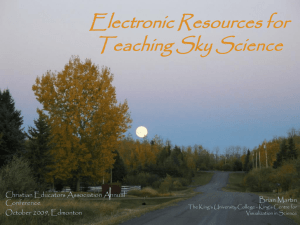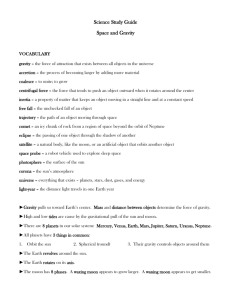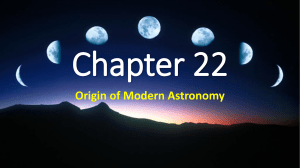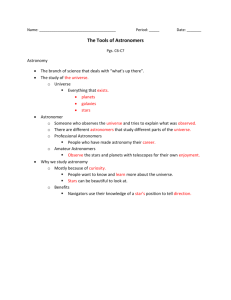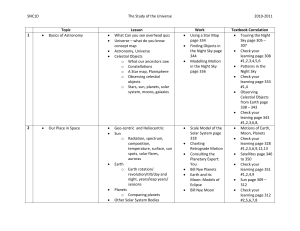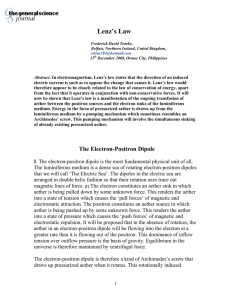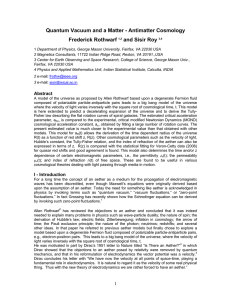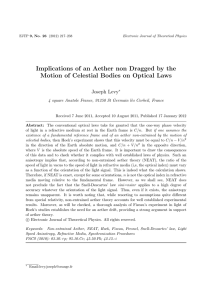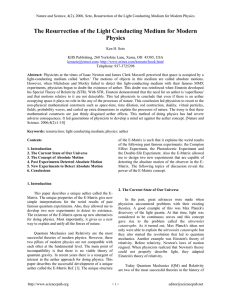Ancient Physics
advertisement
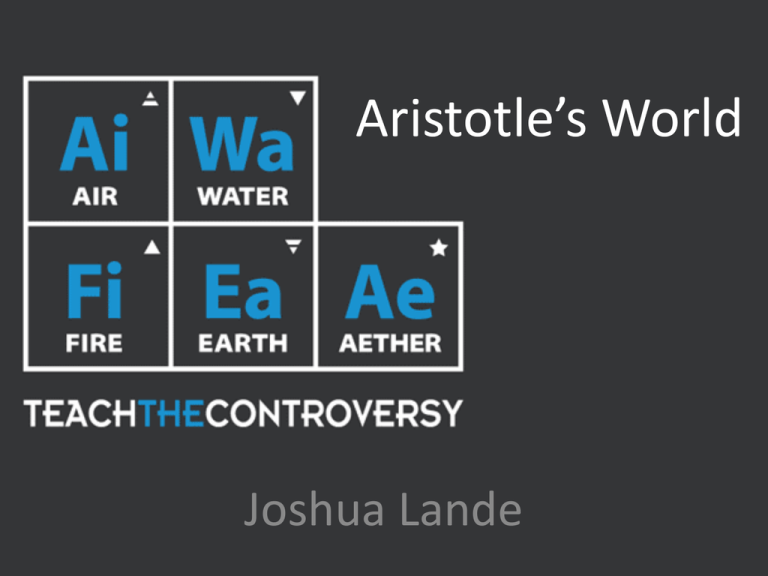
Aristotle’s World Joshua Lande Aristotle (384 BC – 322 BC) • Born of a well-to-do family in the Macedonian • In 384 BC. • At 17 he went to Athens to study at Plato’s Academy. • He remained for the next 20 years. Aristotle’s Physics • Is amazingly plausible, coherent, and common sense. • Lacks Mathematical rigor • “Mathematics was concerned with unchanging objects that lacked reality, while his natural philosophy focused upon changing objects with a reality of their own.” • Almost fully accepted until the Copernican revolution. The Qualities • Four fundamental quantities – Hot, cold, dry, & wet • Hot & cold are active quantities • Addition or subtraction will change things • Wet & Dry are result of action of active quantities • Fundamental qualities can be combined in only 4 ways to create the 4 elements Material Science • Four main elements make up the terrestrial world: • earth, air, water and fire. • Earth=Dry + Cold • Water = Wet + Cold • Fire = Dry + Hot • Air = Hot + Wet • Earth is not the same as earth! The Periodic Table of the Elements • 4 elements roughly correspond to 4 states of matter – Solid, Liquid, Gas, Plasma. • Heavy material like rocks and Iron made up mainly of earth • Lighter objects like wood contain more water and air This Can Explain Lots of Observations • Example – Boiling • The addition of heat to a wet object. • The heat draws the wetness (water/air) out • The resulting substance is thicker (more earth) • The separate wetness (water/air) is lighter so rises Theoretical Issue • Ice is dryer and colder than water - contain more earth. • But earth is attracted downwards more strongly. • Strangely ice floats in water? Human Biology • Humans consist of a complex mixture of all the elements: – Earth gives strength and weight – Fire provides warmth – Water for blood and bodily fluids – Air fills lungs and breath of life. • Each human has a different composition making us all unique. The Universe Has a ‘Cosmic Graph Paper’ • In the center of the graph is the geometric center of the universe. • The center of the universe is where all the radial lines converge. Natural State • The natural state of objects is at rest • This is obvious from terrestrial observations • All things put in motion eventually stop Natural Place • All mater has a natural place it wants to go to • The natural ordering is Fire, Air, Water, and Earth • Earth wants to “go down” more than water. • Lightning is fire in the sky. Dynamics • Natural motion caused by objects seeking their natural place • Motion is straight up / down in radial lines • Explains why rocks sink in water but air bubbles rise up • Fire rises through air. Details • Natural motion, proportional to weight. • Explains why rocks fall faster than feathers • The speed of fall depends inversely on the density it falls through. • Explains water resistance, etc • Because of this, there can be no vacuum • Things would move infinitely fast through it Why the Earth is Round • The way for most earthy material to get as close as possible to the center. • The water rest on surface because it wants to be further from center. The real world is more complicated. • Our world isn’t in equilibrium • Water somehow gets pulled up into the atmosphere for a while (clouds) before eventually falling to earth • Fire trapped in things like trees eventually released during burning • Volcanoes occasionally spew earthy and watery and fiery junk into the atmosphere • It lingers for a while before moving back toward its natural place Violent Motion • Only way for an object to move unnatural (in non-rectilinear motion up/down) is violently. • Violent motion happens when one object acts directly acts upon another causing it to move. • So motion only happens when a force is involved. • This explains pushing a boulder up a hill, walking, etc. • Speed of violent motion proportional to force – If you push something harder it moves faster Impossibility of Heliocentric Universe • Imagine a bird taking off and flying • After leaving the ground, it would come to rest • But rest is moving quickly away from the earth • So the bird would leave the earth. Projectiles • Hard to explain • Continues to move in the air instead of immediately falling towards earth • Explanation is that the air in front of the object became disturbed by the movement • Air swirls behind it pushing it along. • This tendency weakens with time Cosmology • Everything in the sky move round in circles. • Other than that, it doesn’t really change. • But our terrestrial world is always in flux. • Therefore, the heavens must be made of an entirely different substance. • This substance is aether, a pure, completely different perfect substance Aether • The main difference between aether and matter is that aether’s natural state is circular motion • Circles are the most perfect geometric shape • Aether means always running The Moon • The Moon marks the boundary between the Earth and the Heavens • It is mostly aether. • Small amounts of earth accounted for the visible imperfections on its surface. • All imperfect celestial objects such as comets, nova, and meteors are sublunar. Cosmology • Heavenly objects move in celestial spheres. • Center is Earth, then moon, then planets, then stars. • Agreement with rough observations. Imperfect Planets • The planets & sun drift relative to the stars • This is an imperfection • Closer bodies are increasingly corrupt by terrestrial elements • E.g. The sun probably contains some fire in it. Dynamical Connection Between Heavens and Earth • Rotation of the outer sphere of stars mechanically responsible for all the other motion in the universe. • The rotation of the stars pulls the planets around • In turn pulls the Sun around • In turn pulls the Moon around • In turn communicates motion to sublunar region. • Plausible – The tides correlates with the motion of the Moon and Sun – So does the daily warming and cooling of the Earth – And yearly progression through the seasons. Questions?
